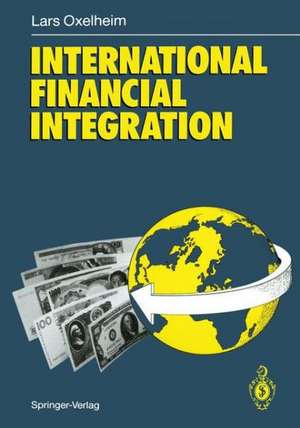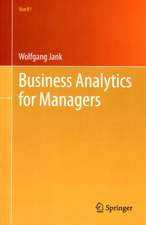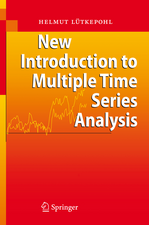International Financial Integration
Autor Lars Oxelheimen Limba Engleză Hardback – 21 mai 1990
| Toate formatele și edițiile | Preț | Express |
|---|---|---|
| Paperback (1) | 648.89 lei 6-8 săpt. | |
| Springer Berlin, Heidelberg – 27 sep 2011 | 648.89 lei 6-8 săpt. | |
| Hardback (1) | 592.37 lei 38-44 zile | |
| Springer Berlin, Heidelberg – 21 mai 1990 | 592.37 lei 38-44 zile |
Preț: 592.37 lei
Preț vechi: 740.46 lei
-20% Nou
Puncte Express: 889
Preț estimativ în valută:
113.36€ • 123.10$ • 95.23£
113.36€ • 123.10$ • 95.23£
Carte tipărită la comandă
Livrare economică 19-25 aprilie
Preluare comenzi: 021 569.72.76
Specificații
ISBN-13: 9783540526292
ISBN-10: 3540526293
Pagini: 412
Ilustrații: XVII, 389 p.
Dimensiuni: 170 x 242 x 28 mm
Ediția:1990
Editura: Springer Berlin, Heidelberg
Colecția Springer
Locul publicării:Berlin, Heidelberg, Germany
ISBN-10: 3540526293
Pagini: 412
Ilustrații: XVII, 389 p.
Dimensiuni: 170 x 242 x 28 mm
Ediția:1990
Editura: Springer Berlin, Heidelberg
Colecția Springer
Locul publicării:Berlin, Heidelberg, Germany
Public țintă
ResearchCuprins
1 The Global Interdependence of National Financial Markets.- 1.1 Many signs of increasing market integration.- 1.2 Previous integration studies demonstrate difficulties in measurement and interpretation.- 1.3 The aim is to measure the level of financial integration.- 1.4 Different forms of financial integration.- 1.5 Interest rate differential or capital flow as dependent variable?.- 1.6 What types of interest rate are relevant to an analysis of financial integration?.- 1.7 What interest rates are the "leaders", as the influence of the US rate declines?.- 1.8 Why is the level of financial integration interesting in a macro-perspective?.- 1.9 What is the significance of the level of financial integration in a micro or corporate perspective?.- 1.10 Is the interest rate in a small open economy determined on foreign markets?.- 1.11 Growing uncertainty raises demands for higher risk premiums.- 1.12 The internationalization of trade.- 1.13 The internationalization of financing.- 1.14 The internationalization of production.- 1.15 Design of the analysis.- 1.16 Plan of the book.- 2 What Is Financial Integration, and Can It Be Measured?.- 2.1 Introduction.- 2.2 Are interest rates determined at home or abroad?.- 2.3 Capital flows and the links between markets.- 2.4 Exchange rate determinants and market expectations.- 2.5 Transaction costs and different types of risk premium.- 2.6 The link between risk and return.- 2.7 Financial integration and monetary autonomy — some measures and analytical approaches.- 2.8 Applied definition and the choice of model.- 2.9 Disintegration and monetary autonomy by way of controls.- 2.10 Problems of measurement and standardization.- 2.11 Collecting primary data.- 2.12 Concluding comment on the methodological problems.- 2.1 Fisher (Domestic)Effect.- 2.2 Variability in interest rates after tax.- 2.3 The International Fisher Effect.- 2.4 Model for determining the exchange rate.- 2.5 Example of a portfolio approach.- 2.6 The interest rate parity theory.- 2.7 Swedish industrial groups with a turnover exceeding SEK 1 billion in 1981.- 3 Results and Findings from Earlier Studies of Financial Integration.- 3.1 Introduction.- 3.2 Studies of the interest-sensitivity of capital flows.- 3.3 Equal expected returns as an indicator of direct financial integration.- 3.4 Observations from the literature — a summary.- 3.1 Adjusting portfolios in an open economy.- 4 Characteristic Features of the Financial Market in a Small Open Economy — the Case of Sweden.- 4.1 Introduction.- 4.2 Actors on the Swedish financial market.- 4.3 Rates of interest and administrative control mechanisms.- 4.4 Swedish exchange controls and their effect on segmentation.- 4.5 The Swedish krona — historical exchange rate patterns and the formation of expectations on the market.- 4.6 Specific measurement problems.- 4.1 Date of abolition of monetary policy regulations, 1978—85.- 4.2 Exchange rate index.- 4.3 Standard deviations in the forward and spot rates.- 4.4 Foreign exchange flows 1974—84.- 4.5 Current account reporting according to SCB.- 5 Fluctuations in Swedish Interest Rates — Historical Patterns.- 5.1 Introduction.- 5.2 Nominal and real Swedish interest rates 1974—84.- 5.3 Correlation between successive quotations of Swedish interest rates.- 5.4 The interest rate pattern and direct financial integration.- 6 Swedish Interest Rate Fluctuations in an International Perspective.- 6.1 Introduction.- 6.2 How Swedish nominal interest rates deviate from foreign interest rates.- 6.3 Deviations of Swedish real interest rates from foreignreal interest rates.- 6.4 What does this initial comparison suggest about financial integration?.- 7 Swedish Interest Rate Dependence: A Correlation Analysis.- 7.1 Introduction.- 7.2 Covariation between Swedish and foreign real interest rates.- 7.3 Covariation between the Swedish nominal interest rate and the foreign rate.- 7.4 Covariation between the Swedish interest rate and the forward-covered foreign interest rate.- 7.5 The correlation analysis and direct financial integration.- 8 A Model-Based Analysis of Direct Financial Integration.- 8.1 Introduction.- 8.2 Analysis of deviations from the International Fisher Effect.- 8.3 Analysis of deviations from interest rate parity.- 8.4 The forward rate as an unbiased estimate of the future exchange rate.- 8.5 Presentation of the model.- 8.6 Analysis of the gap between Swedish and foreign discount rates.- 8.7 Analysis of the gap between Swedish and foreign interest rates on treasury discount notes.- 8.8 Analysis of the gap between Swedish and foreign prime rates.- 8.9 Analysis of the gap between the Swedish interest rate on government bonds/government notes and the corresponding foreign rate.- 8.10 Analysis of the gap between Swedish and foreign interest rates on industrial bonds.- 9 Interest Rate Autonomy and the Foreign Dependence of the Swedish Financial Market — A Summary.- Supplement 1 Mean and standard deviation in the international interest rates 1974—84.- Supplement 2 List of variables and abbreviations.













